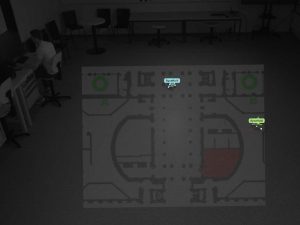
Multi-robot systems provide great benefits in applications such as coordinated search and rescue, large scale agriculture, and efficient transportation of people and goods. This motivates research on novel coordination, planning, and control algorithms. To develop such algorithms it is crucial to test ideas rapidly in a setting that is both repeatable and adaptable to different applications of interest. The objective of this project is to visualise virtual information in real-time in order to augment a multi-robot testbed. Selected data used for the robot decision-making and
control, such as the velocity vectors of other agents, position boundary constraints, or classification of objects, is to be overlaid on video feeds from cameras with dynamic positions and orientations. Furthermore, virtual dynamic environments, such as obstacles, hazards, or objects to be followed, are to be projected onto the ground.
The aim of the project is to create an interactive tool by developing code that integrates into the existing robot control system and experiment setup. The work involves mapping the 2D-pixel arrays of cameras and projectors input to the robot configuration space. The video feed can originate from the robots or from external cameras. The augmentation should account for lens distortion and be adaptable to the camera poses that are estimated through a central tracking system. Similarly, the projector distortion and the positioning need to be accounted for when determining the information that is projected onto the ground to illustrate the environment. The output of the projectors is captured by the cameras. This creates a feedback mechanism that will be used to minimise errors in the mapping. Requirements and key learnings: The student is required to have programming experience (Python) and a solid mathematical background. Experience with ROS (Robot Operating System) is beneficial. Within this project, the student will learn about rigid body transformations and how to integrate new hardware and software into a multi-robotic system.
Interested students should contact Tony Wood.